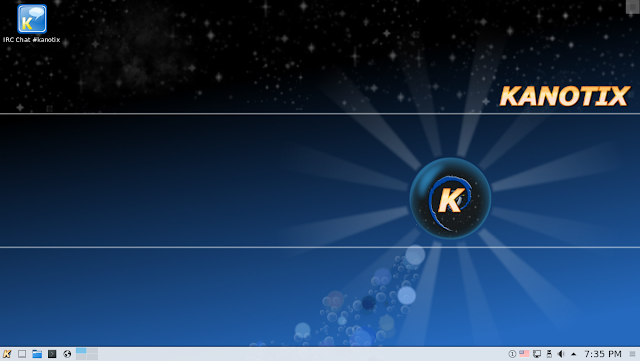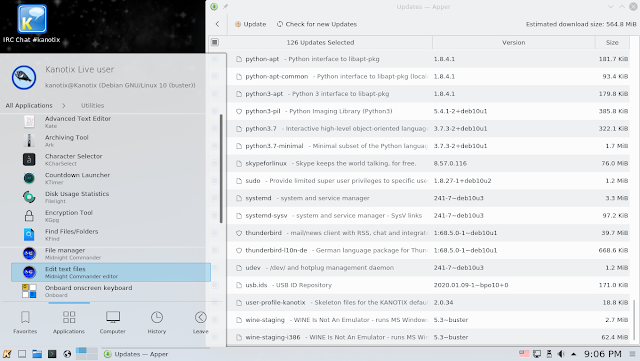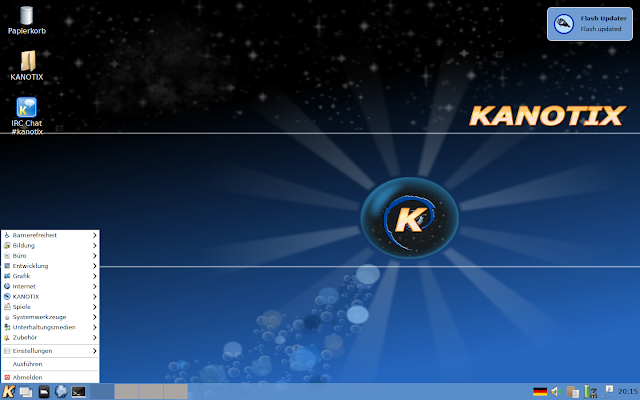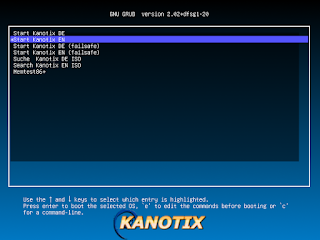 Kanotix is one of those Linux distributions I keep coming back to. I last reviewed it in 2011 when Kanotix 'Hellfire' based on Debian 6 was new. Since then it's been rather quiet but the project is still going strong but it might have slipped under the radar of many Linuxers over the years. Kanotix is always based on the latest Debian stable but development builds are also available and it still has some tricks under its sleeve.
Kanotix is one of those Linux distributions I keep coming back to. I last reviewed it in 2011 when Kanotix 'Hellfire' based on Debian 6 was new. Since then it's been rather quiet but the project is still going strong but it might have slipped under the radar of many Linuxers over the years. Kanotix is always based on the latest Debian stable but development builds are also available and it still has some tricks under its sleeve.There have been no official release announcements on Distrowatch since 2013 but this doesn't mean the project is inactive. The latest release is 'Silverfire' which is based on Debian 10 'Buster'. 'Steelfire' builds based on Debian 9 'Stretch' and 'Spitfire' based on Debian 8 'Jessie' are also currently still available on the downloads page. Builds are updated nightly to incorporate the latest package updates from upstream which explains the nightly tag in the names of the ISO files but these are not beta quality images for testing. Kanotix supports the mainstream 32 bit and 64 bit intel/amd architectures and the latest two releases also support the rather old EeePC4G with special builds.
In their own words
"Kanotix is a rock-solid Linux based on Debian, which contains the newest packages and recognizes more modern hardware than any other operating system in use today.
Kanotix is assembled for 32 Bit i586 and for AMD 64 using the most up-to-date kernel with unique patches.
Kanotix will run as a LIVE-CD on practically any computer..."
Kanotix was originally inspired by and based on the Knoppix live distribution but is offering a somewhat trimmed live system in comparison, without as many tools, rescue utilities and desktop environments. All architectures are offered with the respective KDE and LXDE desktops of their time, KDE 4 in the Debian 8 based release and Plasma in the latest issues. A compressed swap file in Ram is used to make operation more efficient. The live mode is using passwordless sudo, if you get logged out the password for the live user is ´live´.
I tried several of the latest 'Silverfire' nightlies over the last few months. The latest KDE build was a 2.2 GB download. LXDE was 1.71 GB in size.
We can choose from the Grub2 menu whether to boot Kanotix into a German or English language desktop. Kanotix comes with its own look and artwork - the distribution-specific Grub2 background and desktop wallpaper have stayed unchanged for a number of years now. Booting in Virtualbox shows that both keyboard and mouse are captured. Initially I was presented with a screen size of 800x600 but going into system settings allowed me to adjust this to anything up the maximum supported screen resolution.
The desktop - Plasma edition
With the KDE edition we get a standard and quite vanilla Plasma version 5.14 as inherited from upstream, with only a link to the IRC channel for contact and support on the desktop.
 |
| Kanotix KDE Plasma |
You get the usual menu and quick launch bar bottom left and a pager with four pre-set virtual desktops - old school. Firefox is the default web browser, with two entries in the menu for Firefox and web browser. Either one will start Firefox.
Bottom right of the taskbar includes applets for keyboard layout, network, devices, volume, the clock and to change panel settings. Plain KDE Plasma really. The flags to symbolize keyboard layouts look a bit ugly and out of place these days but how else to signal and let people change their language input? Something to mull over. Perhaps someone will come up with a more modern and better looking alternative than just text.
There are only two wallpapers and the Breeze and Breeze Dark themes included, not wasting any space. Most people have their own preferences and picture collections and are perfectly capable of downloading additional themes from within the system settings application as it couldn't be easier. Chances are you won't be running Kanotix for the looks either.
Exploring the menu, there's some serious software included here including the whole LibreOffice suite and Okular, The GIMP and Inkscape, Gwenview, Xsane for image scanning, Skype for Linux, Pidgin and Konversation for messaging and Thunderbird mail, as well as KMahjongg for a quick break from work and with Foobilliardplus even a billiard game.
 |
| Foobilliardplus |
You also get K3B for disc burning, the Clementine jukebox and several video players incl. VLC, the HPlip fax utility, ADSL/PPPOE configuration for external modems, gparted, Konsole and the usual array of KDE system utilities and an onscreen keyboard, a nod to accessibility but also helpful when your keyboard has stopped working due to all the spilt coffee!
Under utilities we find the Kate text editor and Kwrite, the Ark archiving tool, Filelight, the Kgpg encryption tool, Sweeper system cleaner, a calculator, a file search tool and the Spectacle screenshot utility. Midnight Commander with editor mode is also installed just in case one finds themseves at the console and without access to a GUI. For many veteran users this is still the preferred file manager, not just for rescue operations, as there is no need to quit and launch an external editor. Cups is installed for no-frills printing.
 |
| The Utilities submenu and available updates |
To my surprise WINE was also installed, as visible in the list of updates, with Winetricks to help manage it but it first requires to download Mono and Gecko packages to be of any use - which WINE then offers to download for us.
Graphical package management is via Apper and apt-get is available under the hood for updates and to add software. Naturally you have access to the full Debian repositories through Kanotix which are providing their own for their enhancements and customizations. Several multimedia codecs and the Flash Player are already installed and from here it can be extended into any Debian based system you want.
KANOTIX menu - utilities and easy live persistence
Enter the KANOTIX section in the menu. Kanotix can be installed to hard drive with the Acritox installer - don't ask about the name. Similar to antiX and MX Linux this one transfers a live system to hard disk (or SSD). We can either use already existing partitions or opt for manual partitioning with gparted or fdisk. No easy auto option so this is for the slightly advanced user. However, most Linux users should not have a problem with this, the steps are the usual and are quite self-evident. You select the disk and off you go. I created just a root partition in my trial and formatted it with ext4.
Next we select the device for the boot loader and then configure root password and a user. One can enable auto-login and that's it.
The home directory of the live user is copied over to the fresh install, thereby preserving any changes incl. wireless network passwords. At the end the installer removes unneeded packages, i.e. itself. Including the cleanup my install took 10:24 minutes. After the image has been copied to the disk it's time to reboot. Simple and straightforward.
From hereon the usual Debian package management applies. Once installed and updated we can make use of the old and unused kernel remover to prevent too much cruft accumulating.
However, it's probably best used as a live system with persistence as it was originally intended. Kanotix has a few neat tricks that make it fairly unique, mainly because they work so well. One is the Adobe Flash Player auto-updater that ensures one always has the latest and most secure version installed if still needed. It's good to know this runs automatically once the system senses an internet connection and will update your player as soon as, before one has the chance to view sites with an unpatched version.
 |
| Kodi added to the overlay for mobile entertainment |
From my point of view the best is the kanotix-iso-writer USB installer with which we can even create a multi-boot stick, without netbootin or third-party tools. From here you can write any custom install to USB and automagically enable live persistence without having to execute arcane scripts, or write the read-only ISO from one USB key to another to get persistence. This adds another entry to the boot loader for Kanotix (persistence).
The desktop - LXDE edition
The LXDE edition is quite similar, although lighter. It used about 390 MB Ram immediately after start up. Firefox is the default and only web browser here as well, means no Midori. Apart from this you get the typical LX desktop environment with PCManFM 1.3.1. The rest of the application selection is almost identical, save for Geany instead of the native KDE text editors, Hexchat in the internet section, htop, Gdebi for local package installation, a webcam viewer and Seahorse instead of Kgpg to manage keys. Sadly there is no Foobilliard here, instead we get Xskat. Skype is on board as well, for those who depend on it.
Very shortly after boot up the Flash player updated as well, it seemed quicker than in the Plasma version.
 |
| Kanotix LXDE - Flash just auto-updated after boot up |
Kanotix was once in its early days renowned for being laptop friendly back when this was not a small feat to achieve, making wireless and mobile power management easy(-ish). It also had some other advantages of course but as time moved on and technology in other distributions caught up Kanotix seemed not so special any more. However, it has morphed and still has some nice tricks under its sleeve, it's just not very well-known.
I don't actually know which one I like more, the Plasma or the LXDE edition. In the end the choice will depend on the type of task and the resources available.
At the moment it is used here as the base for a portable media center with Kodi and all the plugins from the home setup carried over for those days when I don't want to lug a laptop around.
Update: Since 08-03-2020 so-called extra ISOs for 'Silverfire' are produced to support newer Intel chips and Radeon GK. These extra images have Linux kernel 5.4, Mesa 20.0, support for Virtualbox 6.1 and Android Tools.

I just found Kanotix again. I too used it on and off for many years. It is one awesome distribution and packs so much into it. It is fast, well stocked and runs everywhere as you have written. Every time I "find" Kanotix, I wonder why I quit using it the first time. It is a superb distribution, and really does not get the recognition it deserves.
ReplyDelete